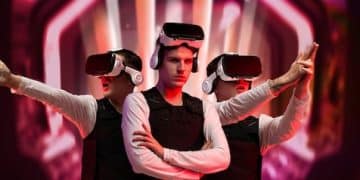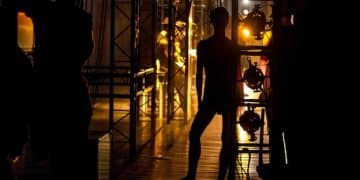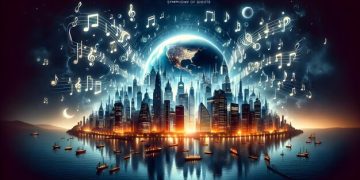The Art of Movie Soundtracks: Boosting Cinematic Experience

The art of movie soundtracks involves a sophisticated interplay of melodic composition, thematic development, and strategic sound design, masterfully engineered to evoke powerful emotions, deepen narrative meaning, and profoundly enhance the audience’s overall cinematic immersion.
From the epic swells that accompany heroic deeds to the subtle, unsettling dissonances that foreshadow danger, The Art of Movie Soundtracks: How Music Enhances the Cinematic Experience is undeniable. Music in film transcends mere background noise; it is a vital, invisible character that shapes our emotional responses, guides our interpretations, and imprints moments onto our memory with an indelible force. This exploration delves into the intricate alchemy that transforms sound into cinematic magic, highlighting its pivotal role in storytelling.
The Unseen Architect: How Soundtracks Shape Emotion
Movie soundtracks are often the unsung heroes of cinematic storytelling, working beneath the surface to manipulate our feelings and perceptions. A skillfully composed score can elevate a scene from good to unforgettable, providing an emotional resonance that visual elements alone might struggle to achieve.
The power of music to evoke specific emotions is deeply rooted in human psychology. Different keys, tempos, and instrumentation trigger distinct emotional responses. A major key, for instance, often conveys happiness or triumph, while a minor key can suggest sadness or suspense. Composers expertly wield these tools to guide the audience’s emotional journey, often without conscious awareness on the viewer’s part.
The Psychology of Cinematic Scoring
Understanding how music interacts with the human psyche is crucial for film composers. They must predict and craft scores that align perfectly with the narrative’s emotional arc. This involves a delicate balance of established musical conventions and innovative techniques.
- Emotional Contagion: Music can directly transfer emotional states to the audience, making them feel joy, fear, or sadness in sync with the characters.
- Predictive Cueing: Subtly hinting at future events or character developments through shifts in musical themes or motifs.
- Memory Anchoring: Iconic themes become deeply associated with specific characters or plot points, triggering recognition and nostalgia.
The absence of music can be just as impactful as its presence. Moments of silence, strategically placed, can amplify tension or highlight the raw vulnerability of a character, demonstrating a composer’s mastery over dynamics and emotional pacing.
Ultimately, a soundtrack’s success lies in its ability to seamlessly integrate with the film, becoming an extension of the story rather than a separate entity. It is an unseen architect, meticulously designing the emotional landscape of the cinematic experience.
Beyond the Notes: The Thematic Richness of Film Scores
A great film score doesn’t just provide background music; it weaves a complex thematic tapestry that enriches the narrative. Through leitmotifs, recurring melodic phrases associated with specific characters, places, or ideas, composers add layers of meaning and continuity.
These motifs evolve with the story, reflecting character development, shifting alliances, or impending danger. For example, a hero’s theme might start triumphantly but become distorted or mournful as they face adversity, only to return with renewed strength in victory. This musical journey mirrors the emotional and narrative journey on screen.
Motifs, leitmotifs, and Sonic Storytelling
The intelligent use of leitmotifs is a hallmark of masterful film scoring. Composers like John Williams are renowned for their ability to create memorable and adaptable themes that resonate profoundly with audiences.
- Character Themes: Distinct musical signatures for central characters (e.g., Darth Vader’s Imperial March).
- Location Themes: Music that immediately conjures a specific setting or environment (e.g., the Shire theme in “The Lord of the Rings”).
- Concept Themes: Melodies associated with abstract ideas, such as love, destiny, or doom, evolving as these concepts are explored.
Sonic storytelling extends beyond simple note patterns. It encompasses orchestration, instrumentation, and even sound effects that are integrated into the score. The choice of instruments – a soaring string section for romance, booming brass for action, or a solitary piano for introspection – profoundly impacts the message conveyed.
This thematic richness ensures that the music is not merely an accompaniment but an active participant in the storytelling, providing subtext and emotional depth that visuals alone cannot always achieve. It allows for a deeper, more nuanced understanding of the film’s underlying messages.
Historical Echoes: Milestones in Soundtrack Evolution
The journey of film music is a historical saga, mirroring the evolution of cinema itself. From the days of live orchestras providing accompaniment to silent films, to the advent of synchronized sound and the rise of iconic composers, soundtracks have continually adapted and innovated.
Early cinema had its limitations, but musicians were quick to fill the void, improvising or playing pre-written pieces that set the mood. The true revolution began with the “talkies,” ushering in an era where music could be meticulously crafted and seamlessly integrated into the filmmaking process.
From Silent Films to Symphonic Masterpieces
The progression from the rudimentary musical cues of silent films to the complex orchestral scores of contemporary blockbusters is a testament to artistic and technological advancement.
- Silent Era Accompaniment: Live musicians, often pianists or small orchestras, provided atmospheric sound.
- Golden Age of Hollywood: Emergence of legendary composers like Max Steiner (“Gone With the Wind”) and Alfred Newman, establishing conventions of symphonic scoring.
- New Hollywood Era: Experimentation with different genres, incorporating jazz, rock, and electronic music, alongside traditional orchestral scores.
The 1960s and 70s saw a diversification of film scores, driven by innovative directors and composers who pushed boundaries. Ennio Morricone’s iconic Western scores, with their distinctive instrumentation and atmospheric sounds, redefined expectations. Bernard Herrmann’s collaborations with Alfred Hitchcock demonstrated how music could be a primary source of suspense and psychological tension.
Today, film composers have an unprecedented array of tools and stylistic influences at their disposal. The history of film music is a rich tapestry of creativity, adaptability, and an ongoing quest to enhance the cinematic experience through sound.
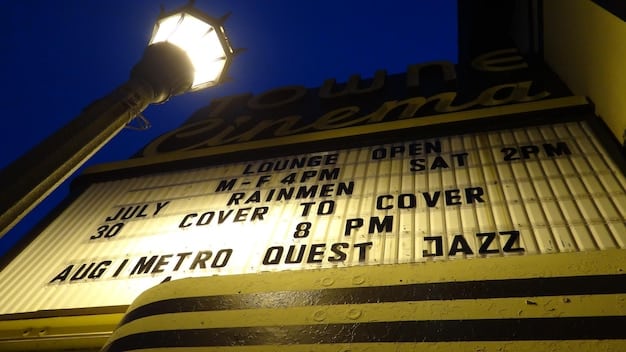
The Modern Maestro: Contemporary Approaches to Scoring
Contemporary film scoring reflects a dynamic blend of traditional techniques and cutting-edge innovation. Modern maestros are adept at pushing genre boundaries, incorporating electronic elements, world music, and unconventional sounds to create unique sonic identities for films.
The digital revolution has profoundly impacted how scores are composed, produced, and distributed. Synthesizers, samplers, and sophisticated digital audio workstations (DAWs) offer composers unparalleled flexibility and creative freedom, allowing for intricate layering and manipulation of sounds.
Innovation in Orchestration and Technology
Today’s composers often fuse grand orchestral arrangements with electronic soundscapes, creating hybrid scores that are both sweeping and intimately textured. This blend allows for incredible versatility and supports a wider range of cinematic storytelling.
- Hybrid Scores: Combining orchestral elements with electronic sounds, offering unique textures and emotional ranges.
- Minimalism: Using fewer, but highly impactful, musical elements to create atmosphere and tension (e.g., Jonny Greenwood’s scores).
- Source Music Integration: Skillfully weaving pre-existing popular songs into the narrative, often for thematic resonance or character establishment.
Beyond traditional composition, sound design plays an increasingly crucial role, blurring the lines between foley, sound effects, and musical elements. Composers and sound designers often collaborate closely to construct comprehensive auditory worlds that completely immerse the viewer.
The modern maestro faces the challenge of creating scores that are both innovative and timeless, serving the immediate needs of the narrative while also leaving a lasting impact on popular culture. This era is characterized by bold experimentation and a relentless pursuit of sonic perfection.
From Studio to Screen: The Collaborative Art of Film Music
Creating a film soundtrack is a deeply collaborative process, involving a complex interplay between the director, composer, music editor, sound designer, and many other talented individuals. This intricate dance ensures that the music perfectly serves the film’s vision.
The journey often begins early in pre-production, with the director sharing their artistic vision and initial ideas with the composer. This early involvement allows the composer to fully grasp the film’s emotional core and thematic intentions, fostering a deeper connection to the material.
The Interplay of Vision and Sound
Effective collaboration is paramount. Directors and composers communicate through mood boards, temp tracks (temporary music used during editing), and detailed discussions to refine the score’s direction. Misalignment can lead to a disconnect between visuals and sound.
- Director’s Vision: Providing the overarching emotional and narrative goals for the score to complement.
- Composer’s Interpretation: Translating the director’s vision into musical form, often presenting multiple options.
- Music Editing: Precision placement of musical cues within the film to maximize impact and flow.
The iterative nature of this process involves countless revisions, trials, and adjustments as the film takes shape. Music editors painstakingly synchronize the score with picture, ensuring that every note aligns with character actions, dialogue, and camera movements. Sound designers layer effects that blend seamlessly with the music, creating a cohesive auditory experience.
This collaborative art form culminates in a soundtrack that feels organic to the film, never intrusive but always enhancing. It is a testament to the collective effort required to transform disparate elements into a unified cinematic masterpiece.
The Resonance Beyond the Reel: Cultural Impact of Soundtracks
The influence of movie soundtracks extends far beyond the confines of the cinema screen. Iconic film scores permeate popular culture, becoming anthems, symbols, and deeply cherished pieces of music in their own right. They shape our collective memory and cultural landscape.
Think of the immediate recognition sparked by the opening notes of John Williams’ “Jaws” theme, or the soaring heroism of Hans Zimmer’s “Inception” score. These are more than movie accompaniments; they are cultural touchstones that evoke powerful emotions and memories, even for those who haven’t seen the films recently.
Soundtracks as Cultural Touchstones
Film scores often transcend their original medium to become standalone works of art, enjoyed by millions globally. They are performed in concert halls, streamed endlessly online, and dissected by music enthusiasts and critics alike.
- Memorable Themes: Scores with distinct, catchy melodies that become instantly recognizable and culturally significant (e.g., “Star Wars,” “Indiana Jones”).
- Award Recognition: Academy Awards and other accolades highlight groundbreaking and impactful scores, raising their public profile.
- Influence on Other Media: Film music inspires video game scores, theatrical productions, and even popular music, extending its reach.
The cultural impact also manifests in how film music becomes shorthand for specific emotions or situations. A particular dramatic chord progression might instantly signal suspense, or a nostalgic melody could evoke a sense of longing. This collective understanding underscores the deep integration of film music into our cultural consciousness.
Ultimately, the resonance of movie soundtracks lies in their ability to evoke universal human experiences through sound. They are a testament to music’s unparalleled power to connect, to move, and to endure, long after the credits roll.
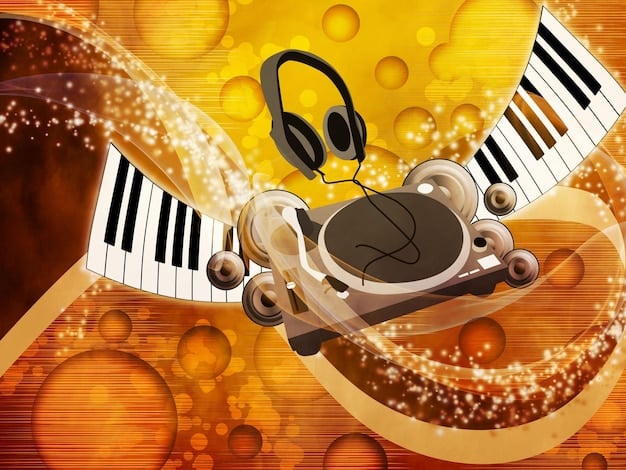
The Future Harmony: Trends and Innovations
The landscape of film scoring is in constant flux, driven by technological advancements, evolving cinematic narratives, and a new generation of composers. The future promises even more immersive and personalized auditory experiences.
Virtual reality and augmented reality platforms present exciting new challenges and opportunities for composers. Music in these interactive environments must be adaptive, responding to user choices and movements, creating a truly dynamic soundtrack experience.
Emerging Technologies and Adaptive Soundscapes
As storytelling formats diversify, so too will the role and form of film music. Composers are exploring new methods of delivery and interactivity, moving beyond linear scores.
- Generative Music: Algorithms that create dynamic, ever-changing scores based on real-time narrative input or user interaction.
- Immersive Audio: Utilizing spatial audio technologies (e.g., Dolby Atmos) to create a three-dimensional soundscape that envelops the listener.
- Personalized Soundtracks: The potential for AI to tailor scores to individual viewer preferences, creating unique emotional experiences.
The continued blending of traditional orchestral elements with electronic music, world music, and experimental sounds will also shape the future of film scores. Composers will likely draw from an even wider palette of global influences, creating truly multicultural soundscapes.
The future harmony of film music lies in its continued adaptability and willingness to embrace new technologies while honoring the timeless principles of emotional storytelling through sound. It promises a rich, varied, and exciting evolution for the art of the movie soundtrack.
| Key Point | Brief Description |
|---|---|
| 🎶 Emotional Impact | Soundtracks directly manipulate audience emotions, deepening narrative connection and enhancing scene impact. |
| 📚 Thematic Storytelling | Through leitmotifs, music provides subtext, character development, and narrative continuity. |
| 🤝 Collaborative Process | Score creation involves deep collaboration between directors, composers, and sound teams for seamless integration. |
| 🚀 Future Innovation | Emerging tech like AI and adaptive audio promise more immersive and personalized listening experiences. |
Frequently Asked Questions About Movie Soundtracks
▼
The primary purpose of a movie soundtrack is to enhance the cinematic experience by evoking specific emotions, foreshadowing events, defining characters, and driving the narrative. It creates a deeper connection between the audience and the story, often subconsciously guiding their perceptions and emotional responses to on-screen events.
▼
Composers create emotional impact by judiciously selecting musical elements like melody, harmony, rhythm, tempo, and instrumentation. For instance, using minor keys often signifies sadness or tension, while a soaring string section can evoke triumph. They also employ variations in dynamics and thematic development to mirror the film’s emotional arc.
▼
A leitmotif is a recurring musical phrase associated with a specific character, place, object, or idea within a film. It’s crucial because it provides thematic coherence, offers subtle insights into character development, or signifies shifts in narrative. These motifs can evolve, reflecting changes in the story or character’s journey, adding depth and layers.
▼
Technology has revolutionized film scoring by introducing digital audio workstations, sophisticated synthesizers, and extensive sample libraries. This allows composers to create complex orchestrations, blend electronic sounds with traditional instruments, and experiment with spatial audio. It offers unprecedented flexibility in sound design and composition, pushing creative boundaries.
▼
The collaboration process for a soundtrack typically involves close communication between the director, composer, and music editor. The director conveys their vision, the composer translates it into music, and the music editor precisely synchronizes the score with the visuals. This iterative process ensures the music seamlessly integrates with and elevates the film’s narrative and emotional impact.
Conclusion
The impact of movie soundtracks on the cinematic experience is profound and multifaceted. Far from being mere background noise, they function as integral storytellers, shaping emotions, defining characters, and imprinting narratives onto our souls. From the early days of live accompaniment to the sophisticated hybrid scores of today, music has consistently proven to be an indispensable layer of the filmmaking process, capable of transforming a visual narrative into an unforgettable emotional journey. As technology evolves, the art of the soundtrack will continue to innovate, promising an even richer auditory landscape for future generations of filmgoers.


